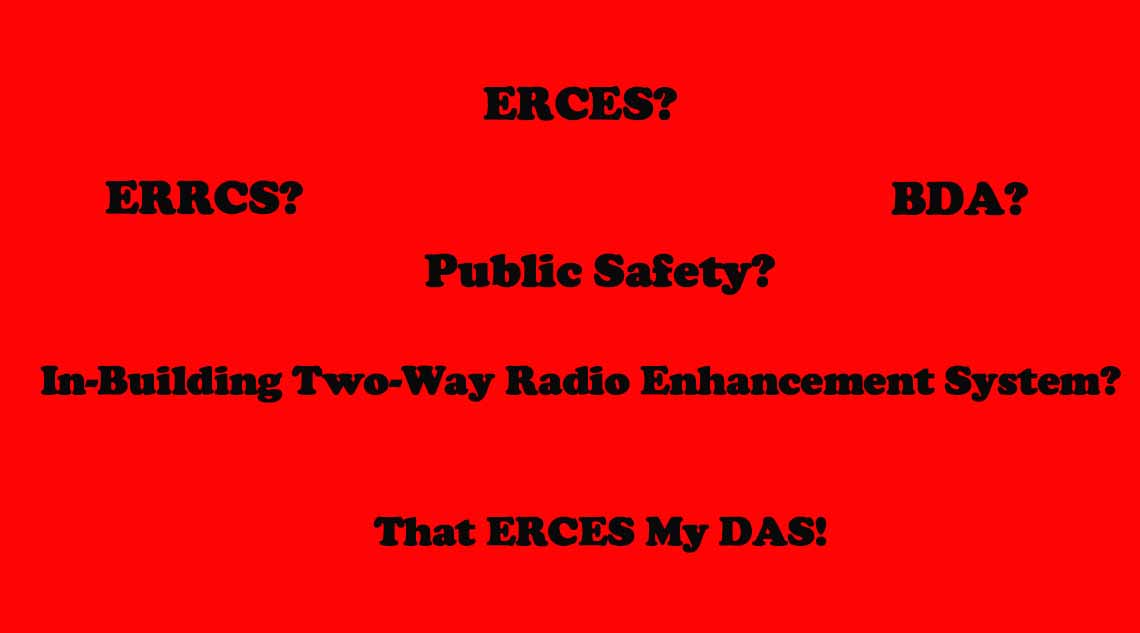What the ERCES! Is it ERCES, ERRCS, BDA, Public Safety, In-building Two-Way Radio Communication Enhancement Systems? That ERCES my DAS! Good GOD, pick a name and use it already!
When it comes to public safety and emergency response, clear and reliable communication is crucial. In today's technology-driven world, organizations and buildings rely on advanced communication systems to ensure a crucial flow of information during emergencies. One such system that is commonly used is the Emergency Responder Communication Enhancement System (ERCES). However, there seems to be some confusion around the acronyms associated with ERCES, including ERRCS, BDA DAS, DAS, and Public Safety just to name a few. Let's dive into the misused acronyms of ERCES and shed light on the importance of these systems in public safety.
ERCES stands for Emergency Responder Communication Enhancement System, and it is designed to boost communication capabilities for emergency responders within buildings. The system ensures that emergency personnel, such as firefighters and police officers, can maintain clear and reliable communication throughout a building, even in areas with poor signal coverage. ERCES systems typically consist of various components, including distributed antenna systems (DAS), bi-directional amplifiers (BDAs), and other equipment that work together to enhance communication capabilities.
ERCES and ERRCS Interchangable Misconception:
One common misconception is the interchangeable use of ERCES and ERRCS. While both terms are related to emergency communication systems, they are not synonymous. ERRCS stands for Emergency Responder Radio Communication System, which is a broader term that encompasses various technologies and systems used to enhance communication for emergency responders. ERCES, on the other hand, specifically refers to systems that enhance radio communication within buildings. It is essential to understand the distinction between these terms to ensure the proper implementation and use of emergency communication systems.
BDA Interchangable Misconception
Another misused acronym is BDA DAS, which stands for Bi-Directional Amplifier Distributed Antenna System. This term is often used interchangeably with ERCES or ERRCS when referring to communication enhancement systems. However, BDA DAS is a specific component of an ERCES system that amplifies radio signals within a building. The distributed antenna system (DAS) consists of antennas distributed throughout the building to ensure uniform signal coverage, while the bi-directional amplifier (BDA) amplifies signals to enhance communication capabilities. Understanding the roles and functions of these components is essential in designing and implementing an effective ERCES system.
The Role ERCES Plays
In the context of public safety, ERCES systems play a crucial role in ensuring the safety and security of occupants within buildings. During emergencies, such as fires, natural disasters, or active shooter incidents, clear communication is essential for coordinating response efforts and evacuating occupants safely. ERCES systems provide emergency responders with the communication tools they need to effectively respond to emergencies and ensure a swift and coordinated response.
One specific application of ERCES systems is in two-way radio communication enhancement. Two-way radios are commonly used by emergency responders to communicate with each other and coordinate response efforts. In-building communication can be challenging due to signal interference and dead zones, which can hinder communication during emergencies. ERCES systems are designed to overcome these challenges by boosting radio signals and ensuring clear communication between emergency responders.
When implementing an ERCES system for two-way radio communication enhancement, it is essential to consider factors such as building layout, signal coverage, and antenna placement. By strategically placing antennas throughout the building and integrating bi-directional amplifiers, organizations can create a robust communication network that enables emergency responders to maintain clear and reliable communication during emergencies.
Why the Acronym Matters:
The misused acronyms of ERCES, ERRCS, BDA DAS, and DAS highlight the importance of understanding the components and functions of emergency communication systems, and the lack of training between each state and municipality. ERCES systems play a vital role in public safety by enhancing communication capabilities for emergency responders within buildings. By implementing an effective ERCES system, organizations can ensure the safety and security of occupants during emergencies and facilitate a coordinated response effort. Clear communication is the key to effective emergency response, and ERCES systems provide the tools needed to achieve this goal. In a system that is so import, why can't we get a universal name that actually applies to what the system is in it's use.
Let's consider the best two names and break them down, ERCES and ERRCS. ERRCS refers to the entire system, including the tower and broadcasting infrastructure in a city. Are you constructing that system? No, so why use that name? On the other hand, ERCES includes the word "Enhancement," in the acronym indicating that it "enhances" an existing communication system (the tower and broadcasting system in place), which is what you are doing. Therefore, it would be more logical to call it ERCES, short for Emergency Responder Communication Enhancement System. Let's name the system accurately and move on so we can all market properly rather than trying to score SEO on all the variations!

